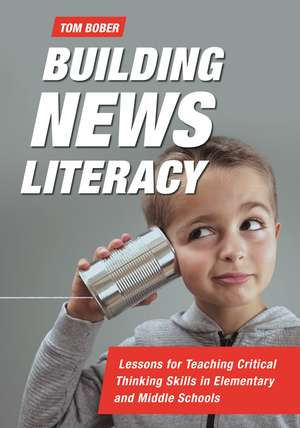Building News Literacy: Lessons for Teaching Critical Thinking Skills in Elementary and Middle Schools
Autor Tom Boberen Limba Engleză Paperback – 4 ian 2021 – vârsta până la 17 ani
Preț: 264.05 lei
Preț vechi: 321.30 lei
-18% Nou
Puncte Express: 396
Preț estimativ în valută:
50.53€ • 52.89$ • 42.05£
50.53€ • 52.89$ • 42.05£
Carte tipărită la comandă
Livrare economică 31 martie-14 aprilie
Preluare comenzi: 021 569.72.76
Specificații
ISBN-13: 9781440875151
ISBN-10: 1440875154
Pagini: 182
Dimensiuni: 178 x 254 mm
Greutate: 0.36 kg
Editura: Bloomsbury Publishing
Colecția Libraries Unlimited
Locul publicării:New York, United States
ISBN-10: 1440875154
Pagini: 182
Dimensiuni: 178 x 254 mm
Greutate: 0.36 kg
Editura: Bloomsbury Publishing
Colecția Libraries Unlimited
Locul publicării:New York, United States
Caracteristici
Be able to implement and adapt targeted lessons focused on learning objectives that build news literacy and other connected literacies in a variety of upper-elementary and middle school learning environments
Notă biografică
Tom Bober is an elementary school librarian in Missouri and author of Elementary Educator's Guide to Primary Sources.
Cuprins
Acknowledgments1-News Literacy in Elementary and Middle Schools?Where Do Elementary and Middle School Students Get Their News?Defining NewsBy FormatBy GeographyHard News and Soft NewsBy Creator or ReporterBy LegitimacyRecruiting Everyone in the EffortWhat This Book Attempts to Do2-Challenges to Be Addressed by Developing News Literacy in StudentsReading Digital vs. PrintTrusting the Messenger and the MessageOrganizing Facts, Commentary, and Personal ReactionsInstilling the Importance of Reliability and CredibilityMaking Sourcing and Contextualizing AutomaticAbandoning Old Approaches to Information and News Literacy3-News Literacy: Tying Together Multiple Literacies Across SubjectsNews Literacy: Made Up of Many PartsText LiteracyVisual LiteracyAudiovisual LiteracyGraphic and Geographic LiteracyComparing News Literacy to Historical LiteracyNews Literacy Across the Subject Areas4-Lessons to Develop News LiteracyDescribing the NewsLesson 1: Fact vs. OpinionLesson 2: What Is News and What Isn'tLesson 3: Differentiating Between News and News CommentaryLesson 4: Reliability and CredibilityNews Analysis StrategiesLesson 5: Sourcing: Taking a First Look at New InformationLesson 6: Contextualizing: Placing News in the MomentLesson 7: Close Reading: Uncovering the StoryLesson 8: Corroborating Information Across Multiple SourcesLesson 9: Asking Questions When Interacting with NewsLesson 10: Word Choice in the NewsLesson 11: Voices in the News: Finding Who Is Heard and Who Is NotInteracting with the NewsLesson 12: Reading Across HeadlinesLesson 13: Curating Sources: Expanding Beyond an Initial ViewLesson 14: Going to the Source: Finding Primary SourcesLesson 15: Making Connections Between News Topics: Cause and Effect in the NewsLesson 16: Stick with the Story: Following News over TimeLesson 17: The Quick Share: Sharing, Liking, and Commenting on NewsUnderstanding Oneself and Others as News ConsumersLesson 18: What Is My Opinion?: Being Aware of Our Own BiasesLesson 19: Rethinking Relationships: Reflecting on Affinities with News SourcesLesson 20: Interacting with and Reacting to Emotionally Charged News TopicsLesson 21: How Will Others Read This?: Predicting Audience ViewpointsReferencesIndex
Recenzii
Practical and user-friendly, with lesson ideas that are ready to implement.
School librarians and teachers will appreciate this logical and easy-to-implement guide to incorporating news literacy into research and inquiry.
School librarians and teachers will appreciate this logical and easy-to-implement guide to incorporating news literacy into research and inquiry.
